Part 53: Appendix D - Units
Appendix D - Units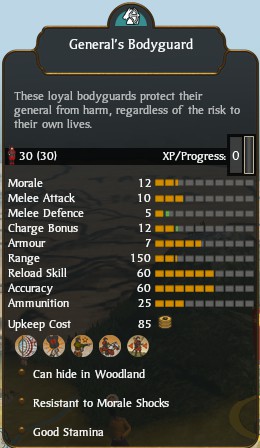
Cost: Special
While these troops are proficient in melee, they are exceptionally skilled with the bow and make a deadly unit that is capable of causing exceptional damage to the enemy forces. With the low quality of most troops in the Genpei War, it is critical that they keep their command aura over units wherever possible. Their high armour makes them very resistant to arrows and cavalry charges.
Ingame encyclopaedia - General posted:
Generals are used to command armies and fleets in battle. Their command rating influences the effectiveness with which their army or fleet fights. When a force does not have a general one of the other units is assigned as the command unit. The command unit does not become a general's bodyguard, its unit type stays the same. In these cases the army fights with a severe disadvantage, as there is no-one to rally or inspire the troops, although the command unit does provide a small morale bonus. A successful battle fought without a general may result in the commander being offered for promotion to general. A general's loyalty to his daimyo, if low, can lead him to defect to an enemy clan. The daimyo is also a general, although in his case personal honour replaces loyalty. The daimyo's sons all become generals when they come of age. Generals can be assigned useful skills and retainers as they gain experience in battle and increase in rank. They can also be assigned commissions to convey additional bonuses.
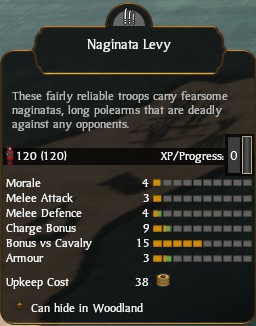


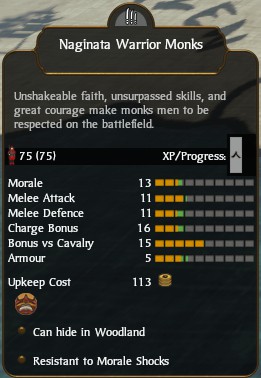
Cost: 235/NA/475/800
Your staple troops for protecting flanks against cavalry and doing most of the screening for ranged troops, Naginata units are effective against all types of troops and only lose to sword units, it would be a foolish cavalry commander that would attack these troops! Despite the blatant lie description for Levy calling them reliable, the only thing they do reliably is die and run away. However, Levy are very cheap, can be made anywhere and replacements are plentiful. Our armour bonus should help keep them alive better than most, but they should still be kept inside the general's aura. Attendants can operate on the flanks without supervision, possessing superior combat skills, armour and morale. With their superior numbers, Attendants can even expect to perform well against Samurai or Monks, although they should not be left engaged against these targets unsupported. Naginata Warrior Monks wield the naginata with unsurpassed skill, each man an equal of a samurai in melee combat while able to obliterate cavalry. In addition, they have the ability to Warcry, reducing the melee defence of enemy units as well as their morale.
Ingame encyclopaedia - Naginata Levy posted:
A naginata is a long staff with a curved blade-like sword on one end. It requires skill to use proficiently, and has much in common with a spear and sword both: it can stab like a spear, or cut like a sword as circumstances require. In skilled hands, for example, it has the reach to decapitate a horseman. Despite their weaponry and their numerical strength, naginata levies are still vulnerable to missile attacks, and should not be expected to defeat the very best quality enemies. Historically, the naginata was a weapon much favoured for self-defence by samurai ladies when their men were away at war. The polearm's length compensated for the difference in height and reach between men and women. It was not, though, a woman's weapon: the sohei monks used it with some skill, and samurai sometimes favoured it for mounted combat. A competent horseman could stand in the stirrups, whirling a naginata and striking at enemies to left and right.
Ingame encyclopaedia - Naginata Attendants posted:
Using naginatas to best effect requires training and dedication, as the long-bladed polearms require strength and co-ordination to use properly. Any idiot can swing a length of wood around, but to do this in the heat of combat and not decapitate yourself or a comrade takes practice. The attendants are a heavy infantry unit, and best used to carry the attack to the foe. They should be deployed in support of the more effective samurai, but can give a good account of themselves in their own right. They should not be positioned where massed ranks of archers can pepper them: arrows are no respecters of their targets' worth. Although numbering in the thousands, the armies of the Gempei War were largely made up of professional warriors; these were not peasants like the ashigaru of the later Sengoku Jidai period. Warriors were expected to have naginata skills to great effect, but the weapon took time to master. By the time of the Sengoku Jidai, however, vast armies were being raised and the best that many warlords expected from their men was relatively simple spear work. An ashigaru was expected to know how to set his spear to receive a charge, and to take part in the "push of pike" scramble of melee, but not to fight with the same level of skill as those who fought with naginatas.
Ingame encyclopaedia - Naginata Warrior Monks posted:
A devout warrior can be very dangerous, for the truly devout have little to fear from death. For these monks, faith is not just a matter of conscience, but another weapon and armour for the soul. It gives them very good morale in battle. The weapons they carry are naginatas, a staff as tall as a man with a sword-like blade fixed to the end. The long reach of these polearms makes them effective against both cavalry and infantry, but this versatility is no protection against overwhelming numbers or against missile attack. The temples at Enryakuji, Miidera and Nara played a key role in the outcome of the Gempei War, giving each family a fighting force of deadly monk warriors. Each temple's choice in choosing allies were often heavily influenced by the actions of the other two temples. Although the Nara and Miidera monks joined forces to aid the Minamoto during the Gempei War, they had been mortal enemies in 1117. As described in the war epic"Heike Monogatari", the monks of Enryakuji and Miidera united against the Nara monks. The Emperor Go Shirakawa is quoted as saying: "Three things refuse to obey my will: the waters of the Kamo River, the fall of backgammon dice and the monks of the Enryakuji Temple."

Cost: 1200
Naginata Warrior Monk Heroes are the ultimate hand to hand warriors, men who have perfected the art of battle with the naginata and now move in a beautiful and deadly dance with those who dare oppose them. Able to engage and destroy any unit, these men represent the pinnacle of Gempei warfare. Such is their commanding aura on the battlefield, that men near them will Hold Firm, making them harder to kill and never faltering. They are still men, however, slain by arrows or massed numbers. For each warrior that falls, scores of enemies will have been slain. The Naginata Warrior Monk Heroes require a Legendary Koryu Dojo and Famous Buddhist Temple.
Ingame encyclopaedia - Naginata Warrior Monk Hero posted:
A warrior with unshakable faith can be very dangerous, for the truly devout have little fear of death. For these monks, faith is not just a matter of conscience, but a weapon. It gives them very good morale in battle. They each carry a naginata, a long staff with a sword-length blade on the end. The long reach makes it effective against cavalry and infantry, but versatility is little protection against missiles. A naginata was weapon similar to the medieval European glaive: a long, wooden shaft with a curved killing blade. The blade varied in length and was, unlike a European glaive, as carefully made as any sword. These distinctive weapons were closely associated with warrior monks. Among the most famous naginata users was Gochin no Tajima, or "Tajima the Arrow Cutter", who fought in the battle of Uji in 1180. Tajima was part of a group of warrior monks pursued by the Taira; he made a stand at a bridge, whirling his naginata with such speed and expertise that arrows bounced harmlessly away.
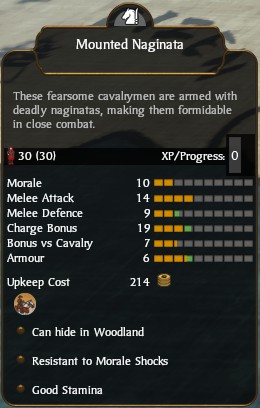

Cost: 700/1150
These skilled horsemen have an exceptional charge and solid bonus against cavalry, as well as having very respectable combat statistics. This makes them perfect for hunting opposing generals and collapsing levy lines. Nevertheless, they will take heavy damage from naginata levy and will be outright slaughtered against naginata attendants, so they should be used with care. Onna Bushi Heroines have exceptional combat statistics and amazing tactical flexibility. While they are very expensive to recruit and field they can be absolutely pivotal. Their ranged statistics are less than ideal, given their exceptionally small unit size (You can expect 8 arrows to hit per volley compared with 13 from a unit of Bow Levy (although it's not that simple)) but that is more than made up for by their exceptional melee combat skills, especially their unbelievable charge. Due to their small size, they should be kept away from massed arrow fire. Despite the fact that they can engage a naginata unit head on and win (barring elite naginata units like Warrior Monks), they should only be used like that as a last resort, as heavy casualties would be the expected outcome.
Ingame encyclopaedia - Mounted Naginata posted:
Naginata cavalry are extremely good in close combat against other horsemen, where the long reach of their weapons gives them a significant advantage. This also makes them quite handy against most infantry, as they can cut down to size - literally, in some cases - almost any opponents. Naginata-armed infantry counter their weapons' strengths quite effectively, as might be expected. Given the small numerical strength of the unit, they are best kept out of range of massed archers: naginatas are no defence against a storm of arrows. While the naginata was a fearsome weapon, Japanese weaponsmiths also produced a hybrid weapon halfway between a sword and a naginata, called the nagamaki. It came to be favoured by some in the period immediately after the Gempei War. This resembled nothing so much as a gently curved sword with a handle as long as the blade. Like the naginata it was used with wide sweeping motions, but could also be used as a spear to stab enemies. Despite being effective, it required a lot of effort to make: some claim more work was involved than for a sword or a naginata, and this inherent expense helped to limit its popularity.
Ingame encyclopaedia - Onna Bushi Heroine posted:
Armed with both deadly naginatas and bows, this small unit of elite ladies have skills to rival, or exceed, those of any man. Mounted on fine horses, they can move quickly to key areas on the battlefield, and can terrify enemy infantry with their impressive charges. As well as being fearsome in melee, this unit of heroines can also act as missile cavalry. A wise commander is careful to keep them out of range of massed archers and away from naginata-armed infantry. The early Emperors of Japan, and their exploits, are clouded in myth and legend. It is often difficult to separate fact from fiction. This is particularly true of the Empress Jingu, who ruled Japan from in the 3rd Century AD. Following her husband's death, she carried out his planned invasion of Korea, because a kami had told her that she would be protected whilst on the expedition. This was particularly fortuitous as she was pregnant at the time. After realising that the birth was imminent she prayed that her child would not be born until her return to Japan. After a successful campaign she returned home and gave birth to a son who would eventually be seen as Hachiman, the great kami of war.
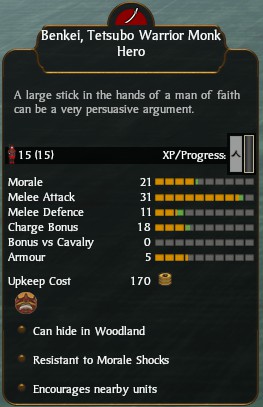
Cost: 1100
The Tetsubo Warrior Monk Heroes are legendary warriors, armed with giant studded clubs. Only the strongest of men can wield these weapons, making them a terror in melee combat, able to beat their opponents with devastating strikes with an unstoppable fury and savagery. This incredible offensive power comes at a cost, however, with the Testubo Warrior Monk Heroes vulnerable to arrow fire and swarming of superior numbers. Warcry further heightens the terror of these warriors, letting them do their savage work more effectively. Used on the flanks or when supported by their own men, these heroes will crush all before them. Tetsubo Warrior Monk Heroes require a Buddhist Monastery and Koryu Dojo.
Ingame encyclopaedia - Tetsubo Warrior Monk Hero posted:
Armed with fearsome large, metal-studded clubs, these warrior monks are a terrifying sight as they charge into the attack. The size and weight of tetsubos makes them horribly effective in close combat: armour only serves to spread the impact of a blow, not keep it out. The monks disdain armour, and this makes them vulnerable to missile attacks. They can also be overwhelmed by large numbers of lesser attackers. The tetsubo is a weapon that requires immense strength to use properly, so it is hardly surprising that oni, the fearsome demons of Japanese legend, are often credited with using these clubs. The reputed strength of oni is still used in saying such as an "oni with an iron club" to mean something that is simply invincible, and "giving a kanabo to an oni" or giving the advantage to someone who already has quite enough advantages, thank you. Oni are still placated, or warded off, in modern Japan: during the springtime Setsubun festival families throw soybeans outside of their homes to bring good luck and ward off passing oni.
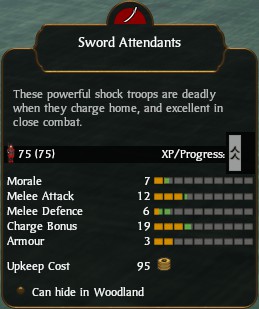
Cost: 550
Sword Attendants are deadly anti-infantry fighters, able to deal devestating damage in both sustained combat and with incredible charges. Able to Banzai to ensure their will is unbroken and their damage dealt is terrible, these men are capable of killing even elite troops with ease. They are weak in defence however, for although they will slay their opponents, they, in turn, will die in sustained melee.
Ingame encyclopaedia - Sword Attendants posted:
Sword attendants are armed with a large powerful swords, impressive weapons that require the strength of both arms to wield effectively in battle. This gives the attendants a fearsome appearance as they charge forward to engage in close combat. Two-handed swords are incredibly sharp and can easily cut through enemies, while the flat sides of the blades can deflect enemy blows. Sword attendants go into battle accepting death and fearing little, but accepting your death and foolishly risking life and limb are not the same thing. They must be wary of threats from cavalry and missile troops, against which they are vulnerable if mishandled. The skill and craftsmanship of Japan's swordsmiths is almost beyond compare. Perhaps only the swords from the forges of Toledo and Dasmascus matched the beauty of Japanese blades, but they did not quite match the sophisticated metallurgy of the Japanese. During the Gempei War the katana, or more correctly, tachi of later centuries had still to develop and become recognised as the classic samurai sword. The skills of the swordsmith were, however, already in evidence. Gempei period swords were just as deadly as their later Sengoku Jidai equivalents when used by an expert.
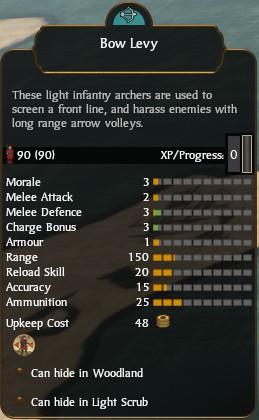



Cost: 285/NA/520/615
Cheap and plentiful, Bow Levy are terrible in melee and will run at the drop of a hat. Under no circumstance should you let a horse get within 100 metres or use them outside the general's aura. However, if they can be properly protected, the low armour of most troops means that they can inflict respectable casualties. Unlike their Levy counterpart, Bow Attendants can shoot reasonably accurately and have enough morale to be able to operate in a skirmishing fashion. They are still exceptionally weak to melee and will lose to anything that isn't Levy in combat. Despite having the same upkeep as Bow Attendants, Bow Warrior Monks have significantly higher morale, better melee skills and armour as well as higher accuracy and slightly faster reload. The downside is that they are harder to replenish and recruit as they require both the Koryu Training Ground and a Buddhist Sanctuary, unlike the Bow Attendants which only need a Bushi Training Grounds.
Ingame encyclopaedia - Bow Levy posted:
Levies do not possess the prowess or prestige of samurai but they are still a formidable force. The numerical size of this unit allows it to provide mass fire support. Once hand-to-hand fighting starts bow levies should retreat to safety behind the battle line, as they are not trained or equipped for melee. They must also be wary near cavalry, as they have little chance of survival when charged by horsemen. Japanese bows at the time of the Gempei War can generally be classified as "long bows" although they differ in a number of ways from their European counterparts. The most obvious difference was the position of the grip, but they were also "composites", made from several different materials, rather than "self-bows" made from a single piece of wood. The bows had to be long to generate power but if the grip had been central it would have been impossible to use the bow from horseback. The lower section would always become entangled with the horse or the saddle. By moving the grip downwards, the asymmetric design allowed the bows to be used easily by mounted archers while keeping them enormously powerful.
Ingame encyclopaedia - Bow Attendants posted:
While almost any man can be trained to shoot a bow well enough to fire in the general direction of the enemy, skill and dedication are needed to shoot accurately and well in the heat of battle. Bow attendants have good morale and are trained well enough for close combat should the need arise. Like many bowmen, however, they are vulnerable if attacked by cavalry. Archery has a long history in Japanese warfare and every samurai was expected to master the art. The bow plays a key role in several Japanese myths. Tamamo no Mae, the beautiful courtesan who stole the heart of the Emperor Konoe, was killed by an arrow fired by Miura no Suke, a mighty warrior. Although Tamamo no Mae was a most beautiful and intelligent woman, she was a kitsune, a nine-tailed fox, working for an evil rival to the Emperor. When her secret was revealed she fled, and Miura no Suke gave chase. Aware that her doom was close, Tamamo no Mae appeared to Miura no Suke in a dream and begged for her life. He refused and fired the fatal arrow the very next day. Tamamo no Mae's fox body turned into the Sessho Seki, the Killing Stone, which legend says kills any who come into contact with it. The stone was haunted by the fox spirit who chose to take the name Hoji, until she was convinced to leave, or exorcised, by Genno, a Buddhist monk.
Ingame encyclopaedia - Bow Warrior Monks posted:
These warrior monks are armed with powerful bows and can attack enemies at a surprising range. They can also bombard foes with terrifying fire arrows. These are especially dangerous in a country such as Japan where wooden buildings are common. Bow warrior monks need careful handling in the presence of the enemy: they are not trained to fight in melee, and are likely to suffer if they are attacked by cavalry. In all probability the small unit size means that they will be quickly cut down in close combat, even with friendly support. Bow warrior monks practiced archery with the same dedication they gave to their religious duties. Indeed, the skill and stillness required for archery was as much an act of meditation as any amount of monkish contemplation. Long years of practice, however, paid off in battle because their bow techniques were so ingrained as to be done without conscious thought or hesitation. Given reasonable weather, monks would, and did, kill everything and everyone foolish enough to stray within bowshot.

Cost: 665
With their rather exceptional combat statistics (and price tag to match) these elite troops are capable of performing every role on the battlefield, from support, to ranged combat, to heavy melee. Unfortunately, the units are exceptionally small (only 45 men per unit) which means replenishment is a long process and they have a very high cost. Like all small units, they should avoid units with powerful charges.
Ingame encyclopaedia - Foot Samurai posted:
To be a samurai was, originally, to be a mounted warrior with bow and spear; mastery of the sword and fighting on foot were later developments. However, once adopted, these new ways were treated with equal sincerity and dedication. Samurai infantry are master archers, capable of hitting targets at impressively long ranges, and also quite capable of defeating enemies in close combat. However, the numerically small size of the unit does make them vulnerable to being overwhelmed by numerous lesser enemies. A wise commander also makes sure they are carefully handled when cavalry threaten. War, the skills of war, and the spirits went hand in hand in Japan. According to the "Azuma Kagami", a written account of the Gempei War, Minamoto Yoritomo's first action when summoned to war was to put on ceremonial robes, and bow towards the Iwashimizu Hachiman shrine. By doing this, the Minamoto Shogun placed the destiny of his family in the hands of Hachiman, the kami of war and the Minamoto's tutelary spirit. To make sure Hachiman continued to favour his clan, Yoritomo had a Shinto priest and a samurai "deeply versed in Shinto ritual" offer prayers on his behalf.
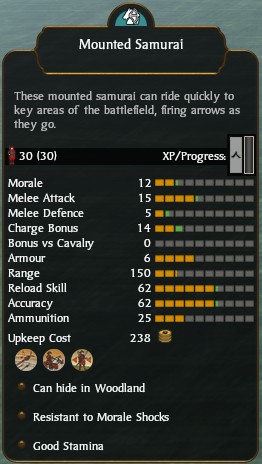
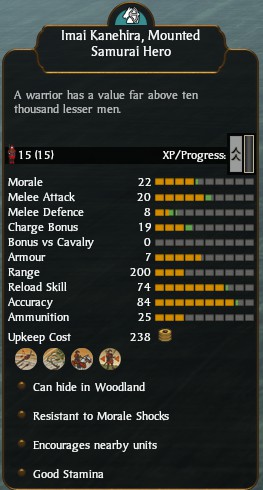
Cost: 800/1300
Able to strike with deadly speed a precision, the Mounted Samurai combine the incredible ranged firepower and melee skill of samurai with the mobility of cavalry. Able to launch the incredible Whistling Arrows, these men are unmatched on the battlefield and provide an incredible mobile terror for the aspiring general. They are vulnerable to massed arrow fire and should not be left in a sustained archery duel, nor should they engage naginata wielding troops in melee. Mounted Samurai require a Bushi Dojo and Pastures. The Mounted Samurai Hero are warriors of complete perfection. Able to launch arrows further than any other man, with accuracy and speed that comes only from a lifetime of mastery, all fear them. Such power inspires the men around them to fight harder and longer than ever before, bringing about a Second Wind. In addition, Mounted Samurai Heroes are deadly melee warriors, able to effortlessly slay all but the most elite troops. Mounted Samurai Heroes are few in number and vulnerable to sustained arrow fire and naginata troops. They require a Legendary Bushi Dojo and Pastures to recruit.
Ingame encyclopaedia - Mounted Samurai posted:
With both hands busy aiming and firing their bows, samurai cavalry must use their knees to control and steer their mounts. This requires intense training for both man and beast. These archers can move quickly to the enemy's flanks, or harass them from a distance. If caught in melee, the samurai have enough training to defend themselves, but they should probably avoid fighting naginata-armed infantry units. Their relatively few numbers makes them vulnerable to a massed attack by archers: weight of numbers will overpower even skilled warriors. Samurai were expected to be proficient in the use of a number of weapons but, during this period, archery was widely regarded as the best way to demonstrate a warrior's true skills. Battles were occasionally settled by mounted archery duels, performed by each army's most skilled archer. Opponents would ride towards one another and fire a single arrow. This "jousting with bows" could be repeated several times as fatal wounds were seldom inflicted during the early passes. The participants were trying their best to kill each other, but their armour was extremely good at keeping out arrows! Instantly fatal wounds were rather difficult to inflict.
Ingame encyclopaedia - Mounted Samurai Hero posted:
These mounted warriors are armed with bows and deadly naginatas, making them powerful in both close and ranged fights. Excellent shots, these men can fire while mounted and ride quickly to critical points of the battle line. Weak only in numbers, the heroes must be careful when near massed archers, and when in close combat against numerically superior forces. They are a deadly force under any general's hand. The samurai ideal of embracing death rather than dishonour plays a large role in the noble, and brutal, mystique of these warriors. The first instance of seppuku, or ritual suicide, is recorded as taking place at the start of the Gempei War. Minamoto no Yorimasa, a 74-year-old poet and warrior, gave up his position with the Taira to join the Minamoto rebellion. He led the Minamoto forces at the Battle of Uji and, following a crushing defeat, chose to take his own life rather than be captured. Legend has it that his retainers took his head, fastened it to a rock, and threw it into a river to keep the Taira from having it. The river had failed to stop the Taira advance.

Cost: 500
Fire Bomb Throwers throw explosive grenades that deal massive damage and cause terror in the troops they strike. They require a lot of skill to use however, as their grenades have no distinction between friend and foe while their melee skills are poor to say the least!
Ingame encyclopaedia - Fire Bomb Throwers posted:
Fire bombs are made from earthenware horoku pots filled with gunpowder. After the fuse is lit, the thrower swings the bomb around his head by the attached rope and then releases it, hopefully hurling it into the enemy ranks. The resulting blast can be terrible as the pot shatters into razor-sharp shards, and it has a terrifying morale effect too. These fire bombs can also be used against enemy walls. Fire bomb throwers are not close-combat experts, and need protecting from the enemy. They do not have the numerical strength to survive for long in a melee. In reality gunpowder was not introduced into Japan until the Mongol invasion of 1274. However, the Chinese were known to be using gunpowder weapons as early as 904AD. Chinese alchemists had spent years trying to discover an elixir that would allow their Emperors to live forever. This quest failed, but one alchemist did create a mixture of 5 parts saltpetre, 15 parts charcoal and 10 parts sulphur that burned violently in the open air, and explosively when confined. Gunpowder would change the face of warfare for generations to come, but quite why anyone would think such a hellish mixture would be an immortality potion is hard to explain!

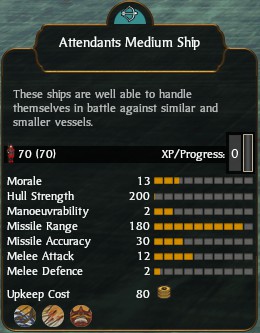
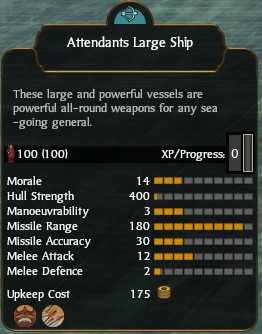
Cost: 150/350/550
The Attendants Light Ship is the naval equivalent of a Levy unit. Cheap and unreliable, but they have their uses. Any ship can carry a full stack of troops and an unlimited number of agents, so this is a transport more than a warship. A staple of the fleet, Attendants Medium Ships are not as fast as their Light cousins and not as well manned as their Heavy cousins, but their strength is in their flexibility. Able to use devastating Fire Arrows, capable of Fast Rowing and able to unleash the mighty Warcry, there is no naval role that this ship is unsuitable for. Manned only by Attendants, it will have difficulty engaging Samurai ships. The Attendant Heavy Ship is a terror of the seas, slow and powerful, able to overwhelm even a Samurai Medium Ship with it's large crew complement. Able to unleash a terrifying Warcry and Fire Arrows, the lack of mobility is this ships key weakness.
Ingame encyclopaedia - Attendants Light Ship posted:
The crews of attendant light ships can bombard enemy vessels with arrows, and the ships have enough speed to extend the range and get out of the way of any counterattacks, should the need arise. The ships are also swift enough to menace any stragglers in an enemy fleet. They are not, however, all that much use in close-in, boarding fights. Their crews do not necessarily have the strength to launch successful attacks against other warships, or withstand a boarding attack for long. While they have high morale, the crew are not samurai, and cannot fight as well as samurai. A balanced fleet in any time of war requires lighter, smaller, handier ships to act as scouts and to escort the heavier warships. These small vessels should not be expected to do much of the work in battle, but they are necessary to keep the enemy off balance, to provide covering fire, and to hopefully lure the opposing admiral into doing something ill-advised, such as pursuing annoyances rather than keeping formation and concentrating on the large enemy ships.
Ingame encyclopaedia - Attendants Medium Ship posted:
Attendant medium ships are solid, dependable vessels without any particular weaknesses. Their all-round usefulness, however, means that they are not outstandingly fast: they are a compromise, and like all compromises, excellence in any particular area is sacrificed in the interests of adequacy overall. Their crews are armed with bows and swords, giving them the ability to board enemies or stand off and pepper them with arrows. The crew have good morale, but they are not capable of taking on samurai in an equal or fair fight. A good commander needs to give them every advantage if they are to succeed against samurai. Historically most naval powers have had to build ships that are a compromise between speed, manoeuvrability and combat power. They also have to keep an accountant's eye on the cost of their warships. Usually the end result is a ship that can do most things quite well, but nothing brilliantly. The Japanese were no different in having to address these problems, with an additional one that their fighting men regarded satisfying honour as more important than good seamanship.
Ingame encyclopaedia - Attendants Heavy Ship posted:
Able to attack at range with arrow fire, and by boarding, attendant heavy ships are an extremely useful part of any balanced fleet. Like many Japanese vessels, they are intended to use boarding actions to defeat the enemy, with on-board soldiers swarming over the enemy decks. Given the soldiers' high morale, this is a valid stratagem, and one that regularly wins battles. So, these powerful vessels and their crews are almost capable of taking on anything else afloat: almost, but not quite. Against well-handled large ships with samurai aboard, they will generally get the worst of any fight. Apart from that, they should be a terror to anything else afloat. No general of the Gempei period wasted much time with considerations of wind and wave. He knew that the way to victory lay in putting his vessels alongside the enemy as quickly as possible and turning the affair into a floating land battle. The better commanders did recognise that there was a good deal of sense in trying to isolate and attack individual squadrons within enemy fleets, gaining local superiority before moving on to fresh victims. The poorer commanders just let their men have their heads and go into battle pell-mell, trusting to swordsmanship and honour to carry the day.



Cost: 200/450/650
The Samurai Light Ship is the smallest of the elite ships, able to easily take a Small or Medium Attendant ship in combat. Armed with Whistling arrows and the deadly accuracy of the samurai, few can stand against them. However, their small crew size makes them vulnerable to being surrounded or mobbed by sheer numbers. The Samurai Medium Ship is the slowest of the samurai ships, but with a large crew complement and access to the devastating Warcry, the only ship that can stand against it is the mighty Samurai Large Ship. The Samurai Large Ship lacks the burst speed available to the lighter ships, but the many rowers give it a respectable top speed. With an exceptionally large crew complement of the finest samurai, this ship is a terror on the seas, able to crush many lesser foes with ease. Armed with Whistling Arrows and packing the dual punch of Warcry and Rally, no other ship could hope to outlast them in combat.
Ingame encyclopaedia - Samurai Light Ship posted:
Samurai light ships are the "cavalry" of sea-battles: quick, nimble and capable of striking down unwary enemies. Their samurai crews are armed with bows and swords, meaning that they can attack their targets during the approach, and be surprisingly strong during a boarding action too. Better still, as samurai they have good, solid morale and are unlikely to waver in battle. However, they are vulnerable if fighting larger ships, simply because the respective numerical crew strengths that can be brought to bear. A light ship carries fewer men, and can therefore sustain fewer casualties. A wise commander uses these ships to attack and possibly capture stragglers in an enemy fleet. Their speed means that, against heavier, slower enemy ships, the light ships have the advantage in choosing where and when to fight. Given their relative high speed in action, they can decide whether or not to accept battle at close quarters, engage in an archery contest, or even harass enemies and then withdraw when pursued. Their "bite" when brought to battle is more than adequate thanks to the samurai aboard.
Ingame encyclopaedia - Samurai Medium Ship posted:
These medium ships are well-suited to most naval tasks, and have no real weaknesses. Their samurai crews are all excellent warriors, if not particularly good sailors, and are armed with swords and bows. A samurai medium ship can stand away from a target and pepper it with arrows, or close and board; the samurai warriors make it a formidable force in any boarding action. This dual use gives a commander many options when it comes to battle, although the primary use of these ships is in boarding actions. This ship type is ideally suited to the tactics of the Gempei period. Naval battles nearly always became large scale boarding actions as ships were lashed together and their crews fought savage hand-to-hand battles. Even more so than land battles, no quarter was asked or given, and the losers could expect nothing better than a watery grave. As far and as often as possible, a sea-general would try to engineer mass boarding battles so that his warriors' fighting spirit could be used to full effect.
Ingame encyclopaedia - Samurai Heavy Ship posted:
Samurai heavy ships carry large contingents of soldiers armed with bows and swords. This gives them excellent attacks both at range with arrows and in boarding actions. Against smaller ships, the samurai should have little trouble in sweeping all before them. The samurai also have high morale, thanks to their sense of personal honour: they are unlikely to back away from any fight. The only shortcoming is that their comparatively slow speed means that they can be outrun or outmanoeuvred. The samurai were not natural sea-warriors. Their strengths, traditions, habits and inclinations were all about combat on good, firm dry land. However, by playing to those strengths they were able to give good account of themselves in battle, as long as boarding actions were involved. In terms of seamanship, the samurai were not much help at sea. Manual labour was considered beneath consideration by the warrior classes, and sailing in medieval craft always required a lot of hard work.

Cost: 100
Exceptionally weak in combat, the Trade Ship allows the importing of foreign trade goods (Chinese Texts, Incense) if it is placed upon an appropriate sea trade node. Additional Trade Ships in the fleet increase the number of trade goods that are imported, although with diminishing returns.
Ingame encyclopaedia - Trade Ship posted:
Trade ships are not intended to get involved in any kind of battle. They exist to make a profit carrying cargoes, and crews should only be expected to fight only in defence of their own lives and their masters' goods. At need, trade ships could be used in battle to board enemies, but against any but the weakest of opposition the prospects of success would be very slim. Japan is a land of rugged, difficult terrain and roads were few and far between. During the medieval period, the easiest way of moving any kind of goods over any distance was by water. A few men with a ship could move cargoes that would have required hundreds of loads on land. The ever-present risk of pirate attack meant that no trade ship could ever be completely defenceless, but the best protection against pirates was always to see them coming and sail in the opposite direction as speedily as possible!

Cost: 400
Firebomb Ships use devastating exploding claypots loaded with gunpoweder to inflict fear and confusion upon enemy ships, as well as to set their foes alight. Short ranged, vulnerable to arrow fire and boarding, these ships must be used carefully, but are capable of the destruction of every other ship in the game. Available only at a Drydock and requiring support, properly used these ships are unbeatable. Their crew consists of the bravest and strongest men, able to row at great speeds or draw upon the fury of Banzai! to ensure the job gets done, no matter the cost.
Ingame encyclopaedia - Firebomb Ship posted:
Firebomb ships are unusual vessels because they are used to attack the fabric of other ships rather than kill their crews. They have a short range attack that causes much damage, but are vulnerable to boarding counter-attacks: fireship crews are not trained for close combat. Most of their expertise concerns their dangerous and inflammatory weapons, which are pots filled with assorted demonic sulphurous chemicals, and men who use such devices need much courage before they even face an enemy. This gives them excellent morale in battle, as any danger from enemies has to be measured against the danger of the firebombs themselves. Firebomb ship crews have the Banzai special ability. Although gunpowder weapons were not employed during the Gempei War, the technology was available in China and would have been known to the Japanese by repute if nothing else. Gunpowder, and assorted unpleasant ways of using it against enemies, had been invented by accident in China some 200 years earlier. Alchemists had been searching for an elixir of immortality, a quest common to the profession across the world. European alchemists would spend centuries looking for the "philosopher's stone" for its immortal benefits. Gunpowder and its successors, on the other hand, are almost certainly one of the greatest causers of mortality yet discovered.